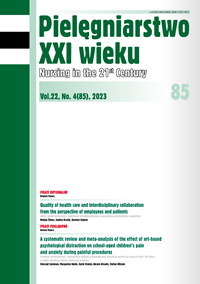Influence of Sociodemographic, Organizational, and Social Factors on the Engagement of Long-Term Care Employees
DOI:
https://doi.org/10.2478/pielxxiw-2023-0040Keywords:
engagements, working environment, long-term care, nursing homes, job resourcesAbstract
INFLUENCE OF SOCIODEMOGRAPHIC, ORGANIZATIONAL, AND SOCIAL FACTORS ON THE ENGAGEMENT OF LONG-TERM CARE EMPLOYEES
Aim. The aim of the study was to identify the most important macro-, meso-, and micro-level factors influencing work engagement and motivation for employment in long-term care (LTC) in Slovenia.
Material and methods. A correlational cross-sectional survey design with a self-reported standardized online questionnaire was used among Slovenian workers (N = 452LTC).
Results. The results show that LTC workers generally enjoy going to work (68%), feel enthusiasm for their work (61%), and take great pride in their work (90%). Enjoyment increases with age, and is correlated with education and position. Joy is the lowest among those working in nursing homes. However, nursing and care teams show the greatest enthusiasm for and pride in the work done. Those who believe that their work is valued by society and their family enjoy going to work more. Although income is the most important factor in leaving the LTC sector, there are no differences in work engagement regarding the level of monthly income. Over 58% of the variance in work engagement was explained by the influence of sociodemographic characteristics, social recognition, and work environment.
Conclusions. To promote employee engagement, LTC leaders should provide a better work environment and social recognition.
References
1. Drennan VM, Ross F. Global nurse shortages - The facts, the impact and action for change. Br. Med. Bull. 2019; 130(1): 25-37. doi:10.1093/bmb/ldz014.
2. Stone R, Wilhelm J, Bishop CE, et al. Predictors of Intent to Leave the Job among Home Health Workers: Analysis of the National Home Health Aide Survey. Gerontol. 2017; 57(85): 890-899; doi:10.1093/geront/gnw075.
3. Bratt C, Gautun H. Should I stay or should I go? Nurses’ wishes to leave LTC settings and home nursing. J. Nurs. Manag. 2018; 26(8): 1074-1082. doi:10.1111/jonm.12639
4. McMichael TM, Currie DW, Clark S, et al. Public Health–Seattle and King County, Evergreen Health, and CDC COVID-19 Investigation Team. Epidemiology of Covid-19 in a Long-Term Care Facility in King County, Washington. N. Engl. J. Med. 2020; 382: 2005-2011. doi:10.1056/NEJMoa2005412.
5. Leskovic L, Erjavec K, Leskovar R, et al. Burnout and job satisfaction of healthcare workers in Slovenian LTC settings in rural areas during the COVID-19 pandemic. Ann Agric Environ Med. 2020; 27(4): 664-671. doi:10.26444/aaem/128236.
6. Midje HH, Torp S, Øvergård KI. The role of working environment and employee engagement in person-centred processes for older adults in long-term care services. Inter. Prac. Devel. J. 2022; 12(2): 1-19; doi:10.19043/ipdj.122.007.
7. Schaufeli WB, Salanova M, González-romá V, et al. The Measurement of Engagement and Burnout: A Two Sample Confi rmatory Factor Analytic Approach. J. Happiness Stud. 2002; 3: 71-92. doi:10.1023/A:1015630930326.
8. Bakker AB, Albrecht S. Work engagement: current trends. Career Dev. Int. 2018; 23(1): 4-11. Doi:10.1108/CDI-11-2017-0207.
9. Bailey C, Madden A, Alfes K, et al. The meaning, antecedents and outcomes of employee engagement: a narrative synthesis. Int. J. Manag. Rev. 2017; 19(1): 31-53. doi:10.1111/ijmr.12077.
10. Hara Y, Asakura K, Sugiyama S, et al. Nurses working in nursing homes: a mediation model for work engagement based on job demands-resources theory. Healthcare. 2021; 9(3): 1-11. doi: 0.3390/healthcare9030316.
11. Wee KZ, Lai AY. Work Engagement and Patient Quality of Care: A Meta-Analysis and Systematic Review. Medical Care Research and Review. 2022; 79(3): 345-358. doi:10.1177/10775587211030388.
12. White EM, Aiken LH, McHugh MD. Registered Nurse Burnout, Job Dissatisfaction, and Missed Care in Nursing Homes. J. Am. Geriatr. 2019; 67(19): 2065-2071. doi. org/10.1111/jgs.16051.
13. Erjavec K. Dejavniki zaviranja in spodbujanja zaposlovanja v dolgotrajni oskrbi. J. Health Scie. 2023; 10(1): 19-35. doi: 10.55707/jhs.v10i1.140.
14. Perruchoud E, Weissbrodt R, Verloo H, et al. The Impact of Nursing Staff s’ Working Conditions on the Quality of Care Received by Older Adults in Long-Term Residential Care Facilities: A Systematic Review of Interventional and Observational Studies. Geriatrics. 2021; 7(1): 6. doi: 10.3390/geriatrics7010006.
15. Lindmark T, Engström M, Trygged S. Psychosocial Work Environment and Well-Being of Direct-Care Staff Under Different Nursing Home Ownership Types: A Systematic Review. J. Appl. Gerontol. 2023; 42(2): 347-359. doi: 10.1177/07334648221131468.
16. Jiang M, Zeng J, Chen X, et al. Construction of a Model of Nurse Engagement in Long-Term Care Facilities: A Moderated-Mediation Model. Front Psychol. 2022; 13:798624. doi: 10.3389/fpsyg.2022.798624.
17. Elstad JI, Vabø M. Lack of recognition at the societal level heightens turnover considerations among Nordic eldercare workers: a quantitative analysis of survey data. BMC Health Serv. Res. 2021; 21: 747. doi:10.1186/s12913-021-06734-4.
18. Innstrand ST, Christensen M, Undebakke KG, et al. The presentation and preliminary validation of KIWEST using a large sample of Norwegian university staff. Scand. J. Public Health. 2015; 43(8): 855-866. doi: 10.1177/1403494815600562.
19. OECD (2023), Beyond Applause? Improving Working Conditions in Long-Term Care, OECD Publishing, Paris. doi:10.1787/27d33ab3-en.
20. Devi R, Goodman C, Dalkin S, et al. Attracting, recruiting and retaining nurses and care workers working in care homes: the need for a nuanced understanding informed by evidence and theory. Age Ageing 2021; 50: 65-67; doi:10.1093/ageing/afaa109.
21. Václavíková K, Kozáková R. Mobbing and its impact on health of nurses–a pilot study. Piel. XXI w. 2021; 20(3): 155-159. doi: 10.2478/pielxxiw-2021-0022.
22. Kulikowski K, Sedlak P. Can you buy work engagement? The relationship between pay, fringe benefits, financial bonuses and work engagement. Curr. Psychol. 2020; 39, 343-353. doi:10.1007/s12144-017-9768-4.
Downloads
Published
Issue
Section
License
Copyright (c) 2023 Authors

This work is licensed under a Creative Commons Attribution 4.0 International License.




